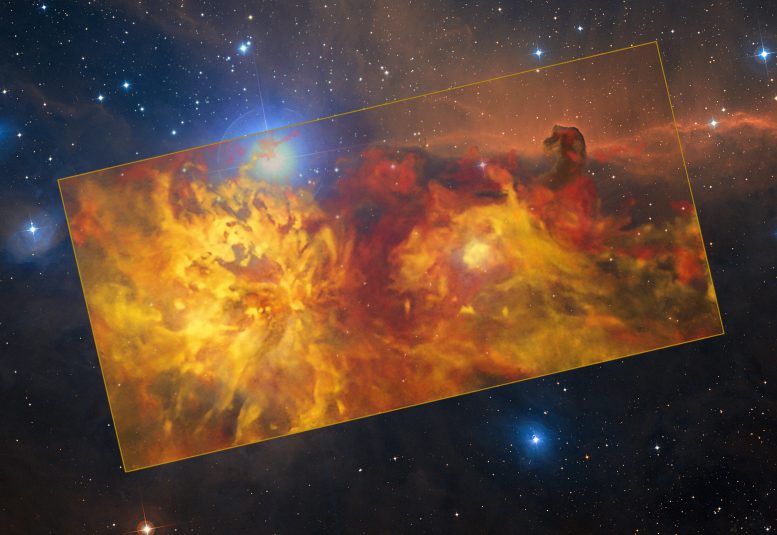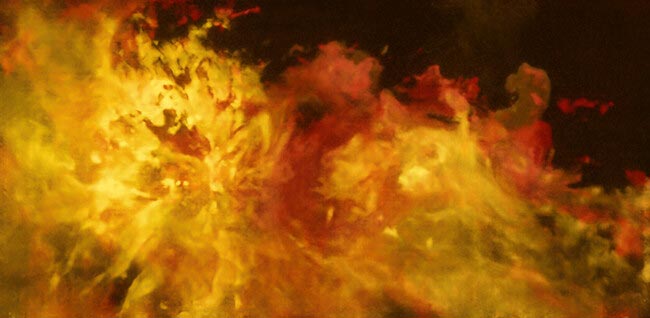Do not let the image and the name of the depicted cosmic object fool you! What you see in this picture is not a wildfire, but the Flame Nebula and its surroundings captured in radio waves.
The Flame Nebula is the large feature on the left half of the central, yellow rectangle. The smaller feature on the right is the reflection nebula NGC 2023. To the top right of NGC 2023, the iconic Horsehead Nebula seems to emerge heroically from the “flames.” The three objects are part of the Orion cloud, a giant gas structure located between 1300 and 1600 light-years away.
The different colors indicate the velocity of the gas. The Flame Nebula and its surroundings are moving away from us, with the red clouds in the background receding faster than the yellow ones in the foreground.
The image in the rectangle is based on observations conducted with the SuperCam instrument on the ESO-operated Atacama Pathfinder Experiment (APEX) on Chile’s Chajnantor Plateau. The background image was taken in infrared light with ESO’s Visible and Infrared Survey Telescope for Astronomy (VISTA) at the Paranal Observatory in Chile.
Credit: ESO/Th. Stanke & ESO/J. Emerson/VISTA. Acknowledgment: Cambridge Astronomical Survey Unit
Orion offers you a spectacular firework display to celebrate the holiday season and the new year in this new image from the European Southern Observatory (
This image shows the Flame Nebula and its surroundings captured in radio waves. The image is based on observations conducted with the SuperCam instrument on the ESO-operated Atacama Pathfinder Experiment (APEX) on Chile’s Chajnantor Plateau.
The Flame Nebula is the large feature on the left. The smaller feature on the right is the reflection nebula NGC 2023. To the top right of NGC 2023, the iconic Horsehead Nebula seems to emerge heroically from the “flames.” The three objects are part of the Orion cloud, a giant gas structure located between 1300 and 1600 light-years away.
The different colors indicate the velocity of the gas. The Flame Nebula and its surroundings are moving away from us, with the red clouds in the background receding faster than the yellow ones in the foreground.
Credit: ESO/Th. Stanke
One of the most famous regions in the sky, Orion is home to the giant molecular clouds closest to the Sun — vast cosmic objects made up mainly of hydrogen, where new stars and planets form. These clouds are located between 1300 and 1600 light-years away and feature the most active stellar nursery in the Solar System’s neighborhood, as well as the Flame Nebula depicted in this image. This “emission” nebula harbors a cluster of young stars at its center that emit high-energy radiation, making the surrounding gases shine.
With such an exciting target, the team was unlikely to be disappointed. In addition to the Flame Nebula and its surroundings, Stanke and his collaborators were able to admire a wide range of other spectacular objects. Some examples include the reflection nebulae Messier 78 and NGC 2071 — clouds of interstellar gas and dust believed to reflect the light of nearby stars. The team even discovered one new nebula, a small object, remarkable in its almost perfectly circular appearance, which they named the Cow Nebula.

The Flame Nebula, captured in radio waves in this image, is the large feature on the left half of the central, yellow rectangle. The smaller feature on the right is the reflection nebula NGC 2023. To the top right of NGC 2023, the iconic Horsehead Nebula seems to emerge heroically from the “flames.” The three objects are part of the Orion’s cloud, a giant gas structure located between 1300 and 1600 light-years away.
The different colors indicate the velocity of the gas. The Flame Nebula and its surroundings are moving away from us, with the red clouds in the background receding faster than the yellow ones in the foreground.
The image in the rectangle is based on observations conducted with the SuperCam instrument on the ESO-operated Atacama Pathfinder Experiment (APEX) on Chile’s Chajnantor Plateau. The background image was created from photographs in optical light forming part of the Digitized Sky Survey 2.
Credit: ESO/Th. Stanke & ESO/Digitized Sky Survey 2. Acknowledgment: Davide De Martin
The observations were conducted as part of the APEX Large CO Heterodyne Orion Legacy Survey (ALCOHOLS), which looked at the radio waves emitted by carbon monoxide (CO) in the Orion clouds. Using this molecule to probe wide areas of the sky is the primary goal of SuperCam, as it allows astronomers to map large gas clouds that give birth to new stars. Unlike what the “fire” of this image might suggest, these clouds are actually cold, with temperatures typically just a few tens of degrees above
